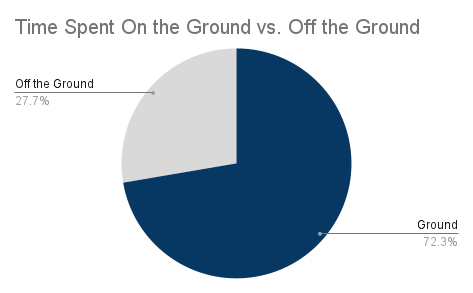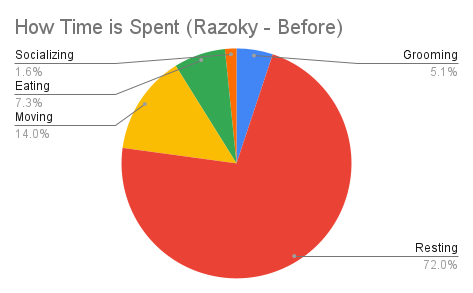Week 10: Final Conclusions Part 1
May 12, 2023
Now that my senior project is coming to an end, I can finally share the data I collected and the conclusions that I have reached. When collecting data, I decided to look at a couple of factors.
The first one is how much time is spent on the ground. When I began this project, time spent on the ground was my biggest focus and the reason for even working on the red ruffed lemur exhibit. It became obvious after my preliminary observations that this was actually not the main problem. Ally spent a pretty decent time on the ground, which is not ideal but expected. Razoky surprised me as he did not spend much time on the ground at all. This was unexpected as I figured that only having a couple of places up high would result in the lemurs coming to the ground as Ally did. Meva spent almost all her time on the ground, but this had nothing to do with the exhibit itself. As Meva is in her late twenties, she is not able to keep up with the active climbing lifestyle of the other two lemurs. Based on my preliminary data regarding time spent on the ground, the exhibit didn’t look to be in too bad of shape.
First: Ally, Second: Razoky, Third: Meva (for some reason it cut off the titles on some of the graphs)



The next factor I looked at was where the time was spent, which functioned as a more detailed version of the previous graphs. Ally and Razoky seemed to cleanly split up their time throughout the exhibit the best they could with what was present. Meva, not surprisingly, spent little time in places other than on the ground. These graphs don’t prove much by themselves but more function as a measure of what structure the lemurs liked in the exhibit to understand how it should be changed going forward.



The final factor was how they spent their time. As it turned out, this was by far the most important data to analyze, specifically time spent resting. The normal percentage of time spent resting for red ruffed lemurs in the wild is 47.4%. Clearly, their current behavior was far from what it should be, which is a huge concern. While the lemurs did keep to the trees like in the wild, they were able to do that by not moving around too much. Razoky is an obvious demonstration of this as he spent the most time up high causing him to be the least active. This is clearly a problem, but not the problem I expected.



In the next blog post, I will reveal the final data from after the exhibit was changed, so stay tuned.

Leave a Reply
You must be logged in to post a comment.